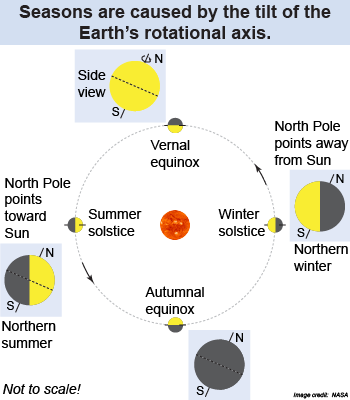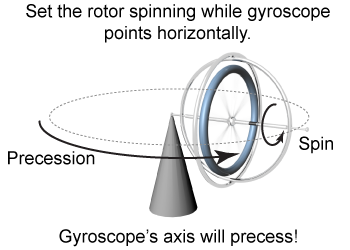|
It is a common misconception that the seasons are caused by Earth being closer or farther from the Sun at different places along the planet’s “elliptical” orbit. This is not the cause of the seasons. Mathematically, a circle is a type of ellipse. Earth’s orbit is so nearly circular that the small variation in distance from the Sun does not explain the large temperature changes that occur with the seasons. Nor does ellipticity explain why summer in the northern hemisphere occurs at the same time as winter in the southern hemisphere. This could not be true if summer were caused by Earth being closer to the Sun. 
|
 The seasons are caused by the orientation of Earth’s rotational axis relative to the plane of its orbit around the Sun. The Earth rotates about its axis once every 24 hours, and it orbits around the Sun once every year. Earth’s rotational axis, however, is not perpendicular to its orbital plane. The Earth’s rotational axis is tilted by 23.4° relative to the orbital axis about which it revolves around the Sun.
The seasons are caused by the orientation of Earth’s rotational axis relative to the plane of its orbit around the Sun. The Earth rotates about its axis once every 24 hours, and it orbits around the Sun once every year. Earth’s rotational axis, however, is not perpendicular to its orbital plane. The Earth’s rotational axis is tilted by 23.4° relative to the orbital axis about which it revolves around the Sun. 
 |
What is the range in latitude of the tropics? The tropics are located between the latitudes of −23.4° and +23.4°. Does this sound familiar? The tropics correspond to the equatorial band of the Earth’s surface on which the Sun will, at some point during the year, pass directly overhead. If the Earth’s axis had no tilt, then only the equator would ever have the Sun pass directly overhead. Owing to the 23.4° tilt of the Earth’s rotational axis, however, the regions of the Earth within ±23.4° latitude of the equator will at some point during the year have the Sun pass overhead. 
|
 Because of the tilt of the Earth’s axis, in January the North Pole tilts 23.4° away from the Sun. This reduces the intensity of sunlight creating winter in the northern hemisphere. Six months later, in June, the North Pole tilts toward the Sun. This increases the intensity of sunlight, making summer. The opposite is true in the southern hemisphere.
Because of the tilt of the Earth’s axis, in January the North Pole tilts 23.4° away from the Sun. This reduces the intensity of sunlight creating winter in the northern hemisphere. Six months later, in June, the North Pole tilts toward the Sun. This increases the intensity of sunlight, making summer. The opposite is true in the southern hemisphere.
The tilt of Earth’s axis also causes polar regions of our planet to have extremes of day and night near the summer and winter solstices. Near the North Pole at the summer solstice, the Sun never sets! This creates 24 hours of daylight. At the same time but near the South Pole, the Sun never rises, creating 24 hours of night. 
|
A strange thing happens to the Earth’s axis of rotation: It rotates slowly around the Earth’s orbital axis, tracing a 46.8° wide circle on opposite sides of the sky. It takes a full 26,000 years for a complete cycle of this precession of the Earth’s axis. 
 |
Have you ever looked up your astrological sign? What is it? Most people don’t realize that, astronomically speaking, they fall under a different astrological sign! When the Babylonians originally set up the twelve zodiacal signs around three thousand years ago, they assigned the sign corresponding to the constellation that the Sun was passing through on the day of a person’s birth.
But the Earth’s rotational axis has been precessing during the three thousand years since then! The sky has shifted, so that the north pole now points to a slightly different area of the sky than it used to. The stars overhead on January 1st in the year C.E. 2000 are different from those overhead in B.C.E. 1000—they have rotated around the sky by 3,000/26,000 or more than 40°. In the table below are the current dates corresponding to the zodiac. Has your sign changed? Current zodiacal signs | Constellation | Date range | Number of days |
|---|
| Sagittarius | December 18 – January 18 | 32 | | Capricornus | January 19 – February 15 | 28 | | Aquarius | February 16 – March 11 | 24 | | Pisces | March 12 – April 18 | 38 | | Aries | April 19 – May 13 | 25 | | Taurus | May 14 – June 19 | 37 | | Gemini | June 20 – July 20 | 31 | | Cancer | July 21 – August 9 20 | 20 | | Leo | August 10 – September 15 | 37 | | Virgo | September 16 – October 30 | 45 | | Libra | October 31 – November 22 | 23 | | Scorpius | November 23 – November 29 | 7 | | Ophiuchus | November 30 – December 17 | 18 | Notice something else strange about the table above: It has 13 zodiacal signs, not 12! For reasons left to history, the original astrological signs omitted Ophiuchus, even though the zodiac passes through this constellation. Could it be that early astrologers considered 13 to be an unlucky number? 
|
 You don’t have to wait 26,000 years to see precession at work. Just use a gyroscope, which you can buy for less than $10! Tilt the gyroscope axis with respect to the vertical—or even point it horizontally. Start the rotor spinning and place one end on its stand. The gyroscope’s rotational axis will precess about the vertical. This precession occurs as a result of the interaction between the angular momentum of the gyroscope and the torque exerted by the gravitational force.
You don’t have to wait 26,000 years to see precession at work. Just use a gyroscope, which you can buy for less than $10! Tilt the gyroscope axis with respect to the vertical—or even point it horizontally. Start the rotor spinning and place one end on its stand. The gyroscope’s rotational axis will precess about the vertical. This precession occurs as a result of the interaction between the angular momentum of the gyroscope and the torque exerted by the gravitational force. 
|
The Arctic Circle represents the northernmost region of the Earth where the Sun can remain above the horizon for 24 hours a day at some time during the year (i.e., around the time of the summer solstice). - What is the latitude of the Arctic Circle?
- If the Earth’s rotational axis were parallel to its orbital axis, how big would the Arctic Circle be?
 |
- In a similar way as the latitude of the tropics is determined, the latitude of the Arctic Circle is determined by the tilt of the Earth’s rotational axis relative to its orbital axis. The Arctic Circle is at a latitude of 90°−23.4° = 66.6°.
- There would be no Arctic Circle. At the North Pole itself, the Sun would skim the horizon every hour of every day during the year.

|
If the Earth’s rotational axis were not tilted with respect to its orbital axis, would the axis still precess?
 |
No, it would not! 
|

